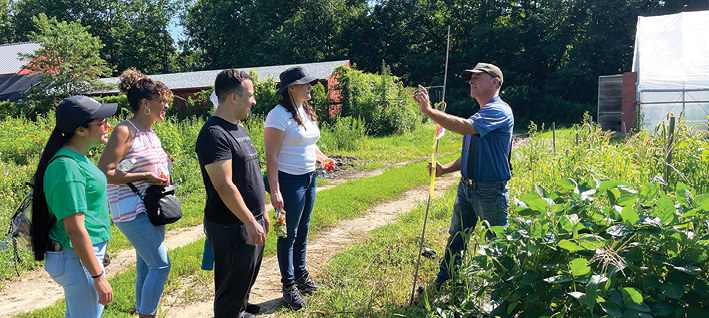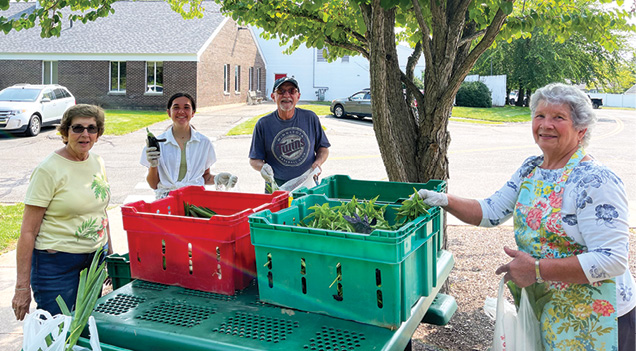We are grateful to the Drummer for providing us this monthly forum and we will squeeze in all we can. If you don’t want to miss anything, and you don’t already receive our “What’s Growing On” email newsletters, drop a note to info@holcombfarm.org and we will add you to our list. -Jenny Emery


Fresh Access in Action: Waste Not Want Not Community Kitchen
Roughly 25 percent of what we grow at Holcomb Farm is provided to people who might not otherwise have access, through our Fresh Access (FA) program. Key to this program is our Institutional Partners who distribute the food we grow directly to their clients.
This month, we highlight the Waste Not Want Not Community Kitchen (WNWN), a local partnership funded largely through the Granby Community Fund. Since 2017, Holcomb Farm FA has provided fresh, nutritious produce to this entirely volunteer-run charity focused on helping those in need. Sandy Flagg leads her hard-working team—as many as 50 volunteers, ranging from students to retirees—to deploy labor, donated foods, goods and monies to deliver a free and wholesome meal every week in a family-style atmosphere, providing a sense of welcome, belonging and comfort for all.
During the pandemic, the WNWN weekly meals became a contactless drive-through for hot meal and food distribution. As conditions changed, the staff transitioned the weekly event to prepackaged take home meals and a food pantry. WNWN happily returned to serving weekly sit-down, community meals this May at the South Campus of the Granby Congregational Church. Each week people gather to enjoy food, friends and family. Holcomb Farm produce is used in the delicious weekly entrée and/or distributed to its diners.
What began as modest weekly produce deliveries has grown; in 2022 the program delivered more than 1,700 pounds of vegetables and fruit to WNWN over its 22-week growing season!

Trees! Trees! Trees!
“And, I ask, if man is not to live by bread alone, what is better worth doing well than the planting of trees?”
—Frederick Law Olmsted 1882.

The Holcomb Farm Tree Trail, on the east side of Simsbury Road, continues to grow. Here is an update from its all-volunteer crew:
One of the design principles on the Tree Trail is to choose trees with spring bloom and fall color. We planted 11 trees in this category this year—five crabapples and six magnolias. All were sourced from Granby nurseryman John O’Brien.
All the magnolias planted are of Eastern North American origin. Five are sweet bay magnolia cultivars (Magnolia virginiana), one of five native magnolias. These have various bloom colors ranging from red, to pink, magenta and white. They may reach 30 to 50 feet tall. The sixth is a cucumber tree magnolia (Magnolia acuminata), which may reach 80 feet high and wide. It too is a native. Younger readers may see its full height someday, but right now it’s only four feet tall.
Crabapples are grown all over the world, and their origins are no longer certain. There are well over 1,000 cultivars. Many have wonderful spring bloom, but then suffer from diseases such as scab and fire blight and look terrible by mid-summer. The breeders have focused on disease resistance, and almost all the best trees now are hybrids of hybrids. Many varieties of apples have been used in developing crabapples. The difference between an apple tree and a crabapple is the size of the fruit—crabapples are fewer than two inches in diameter. Our five crabapples have varying bloom colors from pink, red and white, and with leaf color from green to magenta and purple. They are all going to grow to roughly 25 feet high and wide.

And the season of celebration continues
The Friends of Holcomb Farm invite everyone to join us in celebrating our 30th year of community service. We appreciate all who have stopped by along the way as we work to meet our dual goals: to thank the many members and volunteers who brought us this far, and to entice even more of our friends and neighbors to take advantage of this town resource.
Upcoming events include:
• A DORO Restaurant Group dinner at the North barn, with $25 from each ticket sold benefitting the Fresh Access program, on Sept. 7.
• Open Farm Day on Sept. 16.
• The Granby Land Trust Plein Aire BIG PAINT event on Sept. 24.
• An information exhibit and talk on Oct. 26 at the library.
• The invitation-only Celebration 30 Harvest Dinner honoring board members, donors and volunteers on Oct. 28.
To learn more about any of these events, go to the Events tab on our website (holcombfarm.org). Many thanks to the local businesses and organizations that have helped to underwrite these events through sponsorships.

